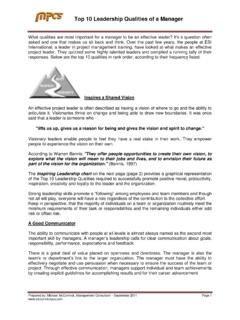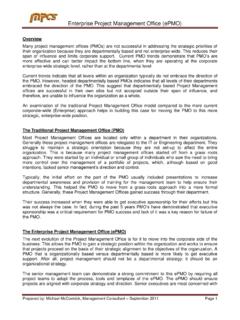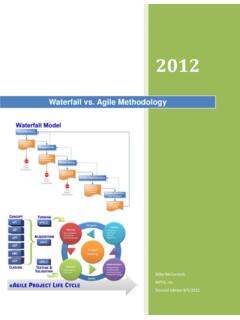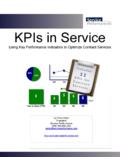Transcription of Key Performance Indicator (KPI)
1 Project Management Key Performance Indicator (KPI) Overview By: Michael McCormick October 21, 2013 2013 Key Performance Indicator (KPI) DLC Project Management Page 2 Prepared By: Michael McCormick Contents KPI Overview .. 3 I. Characteristics of KPI .. 5 II. Requirements of a KPI: .. 5 III. How to design a KPI? .. 5 IV. Key Result Areas .. 5 1. Definition of Key Result Areas (KRA) .. 5 2. Importance of KRAs.. 6 V. List of KPI Mistakes .. 6 VI. KPI Examples .. 6 Construction KPIs: .. 6 KPIs for Project Management .. 10 Performance Reporting .. 11 Work Performance Information .. 11 Project Execution Outputs Work Performance Information .. 12 Baseline Start Date .. 14 Baseline Finish Date .. 14 Technical Performance measurement or Indicators (TPM/TPI) .. 14 TPM Example .. 15 measurement Methodology, Inspection & Acceptance Example.
2 15 Step 1 - Overview .. 15 Step 2 - Daily Monitoring .. 16 Step 3 - Cyclical Evaluations .. 16 Key Performance Indicator (KPI) DLC Project Management Page 3 Prepared By: Michael McCormick KPI Overview A metric, by definition, is any type of measurement used to gauge some quantifiable component of Performance . A metric can be directly collected through observation, such as number of days late, or number of defects found; or the metric can be derived from directly observable quantities, such as number of Change Orders, or a cost Performance index (CPI). When used in a monitoring system to assess project or program health, a metric is called an Indicator , or a key Performance Indicator (KPI). Project metrics can be categorized into three main categories: 1.
3 Pure project management measurements (Example: Estimation accuracy) 2. Indicators of project success (Example: Zero Injuries) 3. Indicators of business success (Example: Positive CPI). At the macro level, metrics management means identifying and tracking strategic objectives. This is often done by the PMO, if one exists. When reporting metrics to management, it is important to keep the time factor in mind. True success or true failure may not be apparent until long after a project is formally closed. Examples of macro-level metrics include: Number of successful projects Percentage of failed projects Number of hours spent per project Number of Change Orders per Project Number of Schedule Delays (Days) Number of Project Schedule Rebaselining Number of Projects Delayed by Pre-construction Process At the micro level, metrics management means identifying and tracking tactical objectives.
4 It is only by looking at the task level metrics that status of higher-level work packages can be ascertained, which can then be reported to project team members. Key Performance Indicator (KPI) DLC Project Management Page 4 Prepared By: Michael McCormick The following criteria are some common tactical measures people want to be updated about: Tactical Measure Question Answered Sample Indicator Time How are we doing against the schedule? Schedule Performance Index (SPI) = Earned Value (EV) Planned Value (PV). =>1 Ideal Index Time Planned to Actual? Schedule Variance (SV): Schedule Variance is computed by calculating the difference between the earned value and the planned value: EV-PV. =>0 Ideal Indicator Time & Cost Weather Impact Number of weather related delay days Cost How are we doing against the budget?
5 Cost Performance Index (CPI) = Earned Value Actual Cost Resources Are we within anticipated limits of staff-hours spent? Amount of hours overspent per work schedule Scope Have the scope changes been more than expected? Number of Change Requests or % of Contract Value exceeds allowance (>3% of CV) Quality Are the quality problems being fixed? Number of commissioning defects and corrective action impact (Days/Man-hours) Quality Client Satisfaction Residential/Commercial Number of Complaints or Damage Claims Action Items Are we keeping up with our action item list? Number of action items behind schedule for resolution Risk Risk Management Number of Risk that changed to Issues Key Performance Indicator (KPI) DLC Project Management Page 5 Prepared By: Michael McCormick I. Characteristics of KPI KPI is a term specifically used to indicate criteria adopted in evaluating an employee s or contractors Performance .
6 Following are some characteristics of KPI: 1. A KPI must be aligned with the organization s objectives; 2. A KPI is determined by management; 3. A KPI must be designed so that it is easy to understand; 4. Some KPIs are specifically designed for each employee or contractor; 5. KPIs are expected Performance by the organization; 6. KPIs must be designed to balance the evaluation of each employee or contractor; 7. KPIs lose their accuracy over time; therefore, it is necessary to revise KPIs periodically. II. Requirements of a KPI: An effective KPI should be: 1. Specific; 2. Measureable; 3. Achievable; 4. Performance relevant; 5. Containing deadline requirement. III. How to design a KPI? 1. Design Key Result Areas (KRAs) and the importance of each KRA; 2. Identify necessary procedures to perform each KRA; 3.
7 Identify the measurement criteria for each KRA and evaluate the importance of each criterion; 4. Summarize the criteria and the importance of each criterion; 5. Develop a summary table of KPIs. IV. Key Result Areas 1. Definition of Key Result Areas (KRA) Key Result Areas or KRAs refer to general areas of outputs or outcomes for which the department s role is responsible. Key Performance Indicator (KPI) DLC Project Management Page 6 Prepared By: Michael McCormick Key Result Area in simple Terms may be defined as Primary responsibilities of an Individual, the core area which each person is accountable. 2. Importance of KRAs. Set goals and objectives Prioritize their activities, and therefore improve their time/work management Make value-added decisions Clarify roles of department or individual Focus on results rather than activities Align their roles to the organization s business or strategic plan Communicate their role s purposes to others 3.
8 Conditions of KRAs Key result areas (KRAs) capture about 80% of the department s work role. The remainders are usually devoted to areas of shared responsibility. Each KRA should capture at least 5 % of work role V. List of KPI Mistakes Building KPI system plays an important role in evaluating job Performance of individual parts, divisions and the company s objectives and Performance management system in general. The development of KPI metrics help to create measurement systems, information systems throughout the organization. When building KPI system, you should note the following factors: Do not create too many, KPI be built around 3-5 KRAs (Key Result Areas). KPI should change to suit each stage (depending on your goals). Limit 3-7 KPIs per process/function. VI. KPI Examples Construction KPIs: 1.
9 % of waste recycled - Percentage of construction and demolition waste recycled. Key Performance Indicator (KPI) DLC Project Management Page 7 Prepared By: Michael McCormick 2. % Construction cost in use - Measures the annual operating and maintenance cost of a construction expressed as a percentage of the actual design and construction cost. 3. Time to rectify defects - Measures the contractor s time to rectify all defects in the maintenance period, from the moment the project is available for use until the end of the contractually agreed period for rectifying defects. 4. Regulation compliance KPIs include: a. Number of small violations per year. b. Number of medium violations per year. c. Number of big violations per year. d. Number of violations by sector. e. Costing lost by violation.
10 F. Time lost by violation. g. Violation rate by department. 5. Liquidity - Determine how much cash your work in progress is generating or consuming by monitoring key current asset and liability balance sheet accounts. 6. Cash flow - Understand whether individual projects are generating or consuming cash so you can better identify execution problems on projects. 7. Actual construction hours vs. Planned construction hours - The actual project construction man-hours are recorded and analyzed against the original planned (baseline) construction man-hours on a monthly basis. 8. Backlog - Properly tracking backlog and the expected gross margins on backlogged work allows construction firms to avoid the problems associated with insufficient work and profit fade. 9. Actual construction time - This KPI is the actual construction time for the contract that formed the basis of the contractor s bid (excluding any extra works).









